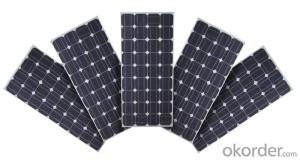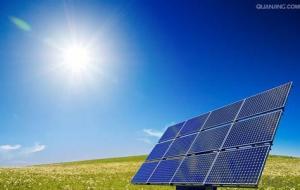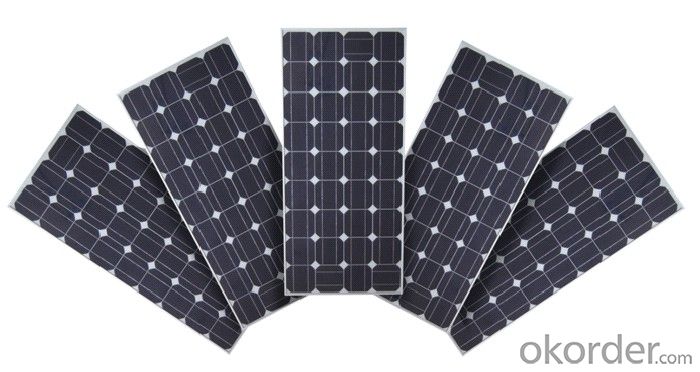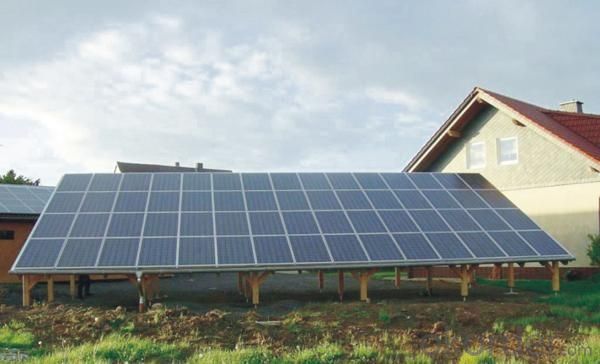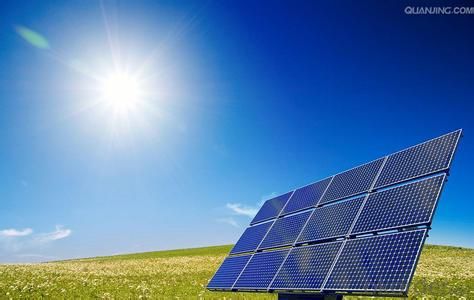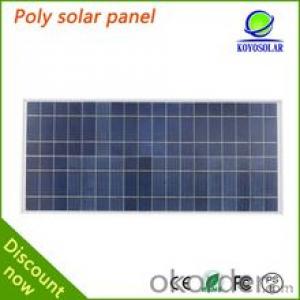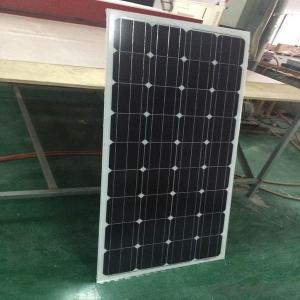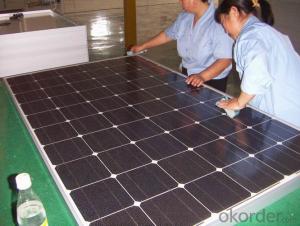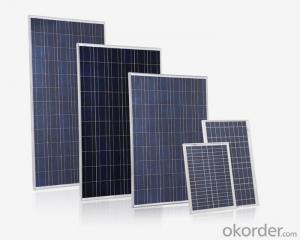Perovskite Solar Cells - Favorites Compare A Grade 300W Solar Panel with Frame and MC4 Connector
- Loading Port:
- China main port
- Payment Terms:
- TT or LC
- Min Order Qty:
- 10000 watt
- Supply Capability:
- 10000000000000 watt/month
OKorder Service Pledge
OKorder Financial Service
You Might Also Like
Quick Details
| Place of Origin: | Guangdong China (Mainland) | Brand Name: | CAP | Model Number: | 50w100w150w200w250w300w |
| Material: | Monocrystalline Silicon | Size: | 1385*1035*75mm | Number of Cells: | 72pcs |
| Max. Power: | 300w | type: | solar panel | color: | blue&black |
| warranty: | 5 years |
Packaging & Delivery
| Packaging Detail: | standard export package for solar panel |
| Delivery Detail: | 7-15 days for solar panel |
Specifications
solar panel
High Efficiency
25 years Warranty
High-transmissivity low-iron tempered glass
Solar Panel
50w100w150w200w250w300w
Characteristics
1,High and stable conversion efficienly based on over 4 years professional experience
2 ,High reliability with guaranteed +/-10% output power tolerance
3,Proven materials,tempered front glass,and a sturdy anodized aluminum frame allow modules to operate reliably in multiple mountily configurations
4,Combination of high efficicncy and attractive appearance
Quality and Safety
1,25 year 80%,10 year 90% power warranty 3 year power warranty
2,ISO9001:2000 (Quality Management system) certified factory
3,Product Quality warranty & products Liability Insurance to guarantee and user' benefits
4,Certifications TUV Intercert, CE Temperature Coefficients
| Module Type | 100w | 150w | 200w | 250w | 300w |
| Maximum Power at ST(Pmax)W | 100wp | 150wp | 200wp | 250wp | 300wp |
| Maximum Power Voltage(Vmp)V | 36/18 | 36/18 | 36/18 | 30.8v | 36/18 |
| Maximum Power Current(Imp)A | 2.77/5.55 | 4.16/8.33 | 5.55/11.1 | 8.11A | 8.33/16.66 |
| Open Circuit Voltage(Voc)V | 39.5/19.05 | 39.3/19.4 | 39.6/19.5 | 36.2V | 39.6/19.8 |
| Short Circuit Current(Isc)A | 3.04/6.09 | 4.58/9.16 | 6.1/12.2 | 8.7A | 9.16/18.33 |
| Cell Efficiency(%) | 18.60% | 18.10% | 18.60% | 17.80% | 18.10% |
| Module Efficiency(%) | 17.70% | 17.20% | 17.70% | 17.10% | 17.20% |
| Operating Temperature°C | -40°C to +85°C | -40°C to +85°C | -40°C to +85°C | -40°C to +85°C | -40°C to +85°C |
| Maximum system voltage | 1000V(IEC)DC | 1000V(IEC)DC | 1000V(IEC)DC | 1000V(IEC)DC | 1000V(IEC)DC |
| Power tolerance | -0.03 | -0.03 | -0.03 | -0.03 | -0.03 |
| Temperature coefficients of Pmax | -0.45%/°C | -0.45%/°C | -0.45%/°C | -0.45%/°C | -0.45%/°C |
| Temperature coefficients of Voc | -0.27%/°C | -0.27%/°C | -0.27%/°C | -0.27%/°C | -0.27%/°C |
| Temperature coefficients of Isc | 0.05%/°C | 0.05%/°C | 0.05%/°C | 0.05%/°C | 0.05%/°C |
| Weight(kg) | 8 | 11 | 14 | 20 | 25.5 |
| Number of cell(pcs) | 4*9 | 4*9 | 6*10 | 6*12 | 6*12 |
| Dimensions(mm) | 1194*534*35/30 | 1580*808*50/35 | 1471*670*40/35 | 1640*992*50 | 2000*1050*50 |
Making More Solar Cells from Silicon
Silicon wafers are the conventional solar cells–they’re what absorbs sunlight and generates electrons. Yet the way wafers are currently manufactured wastes half of the expensive, ultra-pure crystalline silicon they’re made from. When large ingots of silicon are cut into hair-thin wafers, waste silicon is lost as sawdust. The new process–details of which remain secret–produces wafers directly from molten silicon without any sawing. This saves material and reduces the number of steps needed to make solar cells, both of which bring down costs.
How to Grow "Silicon" Crystals to Make Solar Cells
In industry, silicon crystals are grown to form a uniform cylinder of silicon which is used as the base material for crystalline solar cells. There is plenty of silicon about on the earth, in fact, as mentioned previously, after oxygen it is the second most abundant element. When you think that sand and quartz all contain silicon and then imagine the amount of sand in the world, you begin to realize that we are not going to run out of silicon in a hurry!
The problem with sand is that it also contains oxygen in the form of silicon dioxide, which must be removed.
The industrial process used to produce silicon requires temperatures of around 3270oF (which is about 1800oC). Obviously we can't experiment with these3 sorts of temperatures at home - but we can recreate the process!
You are going to need a saturated sugar solution; this will sit in the lid of your coffee jar. Now, take a large crystal of sugar, often sold as "rock sugar" and "glue" it to the end of the skewer. Next, drill a hole the same diameter as the skewer, and poke the skewer through the bottom of the coffee jar. Stand it on a windowsill and lower the crystal into the saturated sugar solution. Over some time, crystals should start to grow - pull the skewer up slowly, bit by bit, so that the growing crystal is still in contact with the sugar solution. This is just like the way that silicon is grown. The silicon is drawn up slowly from a bath of molten hot silicon (which is analogous to our saturated sugar solution).
Once this large crystal of silicon has been manufactured, it must be cut into slices to manufacture the solar cells.
- Q: Can I buy solar cells easily online?
- I think so.
- Q: Can solar cells be used in smart grid systems?
- Yes, solar cells can be used in smart grid systems. Solar cells can generate electricity from sunlight and can be integrated into the smart grid infrastructure to provide renewable energy sources. This allows for decentralized power generation and can help reduce reliance on traditional energy sources, making the grid more sustainable and efficient. Additionally, smart grid systems can enable the efficient management and distribution of the electricity generated by solar cells, further enhancing their integration into the grid.
- Q: Are solar cells durable?
- Yes, solar cells are generally durable. They are designed to withstand various weather conditions, including rain, snow, and extreme temperatures. Additionally, most solar cells come with warranties that guarantee their performance for several decades.
- Q: What is a thin-film solar cell?
- A thin-film solar cell is a type of solar cell that is made by depositing one or more thin layers of photovoltaic material onto a substrate. These cells are typically flexible, lightweight, and have a lower manufacturing cost compared to traditional silicon-based solar cells. They can be used in a variety of applications, such as solar panels for buildings, portable electronic devices, and even integrated into clothing or other surfaces.
- Q: How big are solar cells?
- Solar cells vary in size depending on their intended use and technology. Traditional silicon-based solar cells typically range in size from a few square centimeters to around 200 square centimeters. However, advancements in solar technology have led to the development of smaller, more efficient solar cells, known as thin-film solar cells, which can be as small as a few square millimeters. Additionally, solar cells can be grouped together to form larger arrays, which are commonly used in residential, commercial, and utility-scale solar installations.
- Q: Can solar cells be used in aircraft applications?
- Yes, solar cells can be used in aircraft applications. Solar cells have been integrated into various aircraft designs, including drones and solar-powered airplanes. They are used to capture sunlight and convert it into electricity, which can be used to power the aircraft's electrical systems or recharge its batteries. Solar cells offer a renewable and sustainable source of energy, reducing the reliance on traditional fossil fuels and making aircraft more environmentally friendly.
- Q: What is the largest solar cell installation in the world?
- The largest solar cell installation in the world is the Tengger Desert Solar Park in China.
- Q: Can solar cells be used in public transportation systems?
- Yes, solar cells can be used in public transportation systems. They can be integrated into various components such as the roof or windows of buses, trains, or trams to harness solar energy and power the vehicle's electrical systems, reducing reliance on fossil fuels and lowering carbon emissions. This technology is already being implemented in some cities around the world, offering a more sustainable and environmentally friendly alternative for public transportation.
- Q: Can solar cells be used in floating solar farms?
- Yes, solar cells can be used in floating solar farms. In fact, floating solar farms have gained popularity as an innovative solution to maximize energy production in areas with limited land availability. These floating platforms are equipped with solar panels, which convert sunlight into electricity, just like traditional solar farms. The buoyant structures allow for the installation of solar panels on water bodies such as lakes, reservoirs, and even oceans, making it an efficient way to harness solar energy while minimizing land use.
- Q: Can solar cells be used to power agricultural irrigation systems?
- Yes, solar cells can be used to power agricultural irrigation systems. Solar panels can convert sunlight into electricity, which can be used to power pumps and other equipment necessary for irrigation. This renewable energy source can provide a sustainable and cost-effective solution for powering irrigation systems in remote or off-grid areas.
Send your message to us
Perovskite Solar Cells - Favorites Compare A Grade 300W Solar Panel with Frame and MC4 Connector
- Loading Port:
- China main port
- Payment Terms:
- TT or LC
- Min Order Qty:
- 10000 watt
- Supply Capability:
- 10000000000000 watt/month
OKorder Service Pledge
OKorder Financial Service
Similar products
Hot products
Hot Searches
Related keywords
